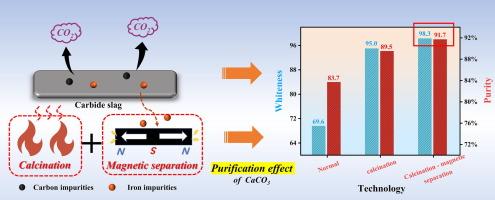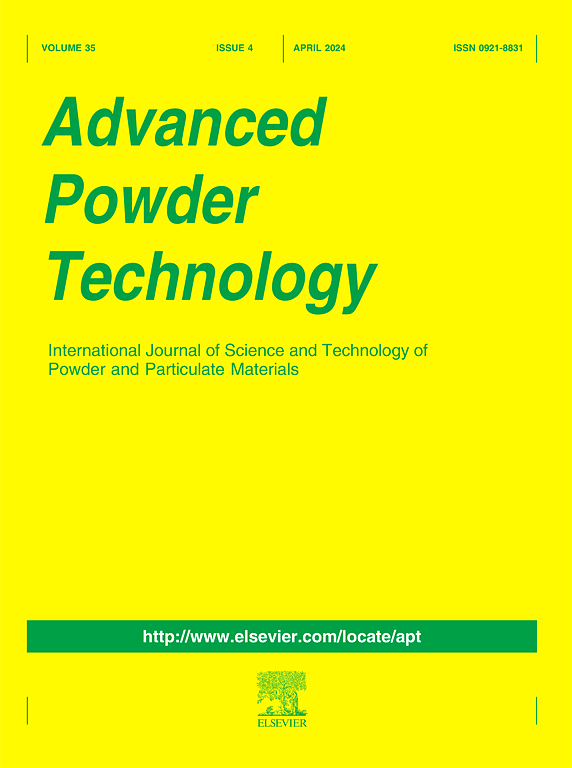电石渣焙烧磁选提高碳化产品纯度和白度
IF 4.2
2区 工程技术
Q2 ENGINEERING, CHEMICAL
引用次数: 0
摘要
电石渣固CO2技术虽然发展迅速,但其固有的杂质严重制约了碳化产物的纯度和白度,阻碍了碳化产物的高价值利用。本研究系统探索并揭示了CS中关键杂质(Al2O3、MgO、Fe2O3、SiO2、CaCO3和单质C)的赋存状态。碳杂质降低碳化效率。Fe2O3作为有色杂质,严重影响产品的纯度和白度。为了克服这一局限性,本研究创新性地结合了煅烧和磁选两种方法来去除杂质。实验结果表明,该工艺能有效去除碳(去除率44.7%)和铁(去除率53.7%),碳化产物纯度和白度分别达到91.7%和98.3%。尽管碳杂质的去除效率和磁性铁杂质的特异性存在挑战,但我们的技术为提高CS碳化产品的质量提供了实用有效的解决方案。这项工作有利于氯碱工业废弃物的资源化利用,有助于实现碳中和的更广泛目标。本文章由计算机程序翻译,如有差异,请以英文原文为准。

Enhancing the purity and whiteness of carbonated products from carbide slag via calcination and magnetic separation
Although the technology of fixing CO2 with carbide slag (CS) has developed rapidly, its inherent impurities severely restrict the purity and whiteness of the carbonation products, hindering their high-value utilization. This study systematically explored and revealed the occurrence states of key impurities (Al2O3, MgO, Fe2O3, SiO2, CaCO3 and elemental C) in CS. Carbon impurities reduce carbonization efficiency. Fe2O3, as a colored impurity, severely affects both the purity and whiteness of the product. To overcome this limitation, this study innovatively combined calcination and magnetic separation approaches to remove impurities. The experimental results revealed that this technology can efficiently remove carbon (removal rate of 44.7%) and iron (removal rate of 53.7%), resulting in the purity and whiteness of the carbonation products reaching 91.7% and 98.3%, respectively. Despite the challenges associated with the removal efficiency of carbon impurities and the specificity of magnetic iron impurities, our technology provides a practical and effective solution for improving the quality of CS carbonation products. This work is conducive to the resource utilization of chlor-alkali industrial waste and helps in achieving the broader goal of carbon neutrality.
求助全文
通过发布文献求助,成功后即可免费获取论文全文。
去求助
来源期刊

Advanced Powder Technology
工程技术-工程:化工
CiteScore
9.50
自引率
7.70%
发文量
424
审稿时长
55 days
期刊介绍:
The aim of Advanced Powder Technology is to meet the demand for an international journal that integrates all aspects of science and technology research on powder and particulate materials. The journal fulfills this purpose by publishing original research papers, rapid communications, reviews, and translated articles by prominent researchers worldwide.
The editorial work of Advanced Powder Technology, which was founded as the International Journal of the Society of Powder Technology, Japan, is now shared by distinguished board members, who operate in a unique framework designed to respond to the increasing global demand for articles on not only powder and particles, but also on various materials produced from them.
Advanced Powder Technology covers various areas, but a discussion of powder and particles is required in articles. Topics include: Production of powder and particulate materials in gases and liquids(nanoparticles, fine ceramics, pharmaceuticals, novel functional materials, etc.); Aerosol and colloidal processing; Powder and particle characterization; Dynamics and phenomena; Calculation and simulation (CFD, DEM, Monte Carlo method, population balance, etc.); Measurement and control of powder processes; Particle modification; Comminution; Powder handling and operations (storage, transport, granulation, separation, fluidization, etc.)
 求助内容:
求助内容: 应助结果提醒方式:
应助结果提醒方式:


